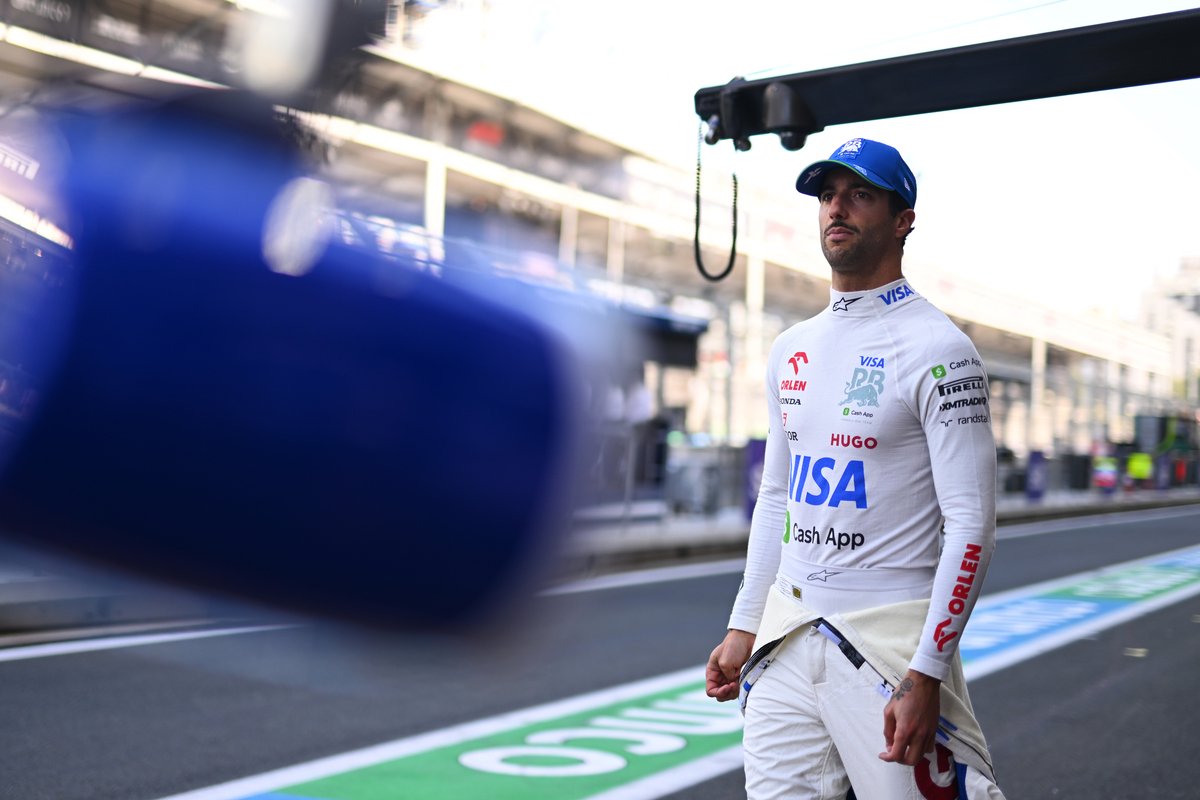

Ricciardo has labelled this year as the start of his second career as he works to rebuild his reputation following two damaging years at McLaren.
Exactly why that relationship didn’t work remains one of F1’s great mysteries, but since joining RB (then AlphaTauri) midway through last year, it has become a distant memory.
But in Saudi Arabia, there was a hint of the old familiar.
Yuki Tsunoda out-qualified Ricciardo, and there was seemingly no explanation for his lack of pace.
It was a concern after a less-than-spectacular season-opener in Bahrain a week earlier, where the Australian admitted to being the weak link in qualifying.
And then, in the race on Saturday, he trundled around at the back of the pack, unable to make an impact.
Post-race it emerged there were reasons for that.
Ricciardo lost a place off the start and then fell further down the order thanks to a slow stop under the Safety Car for Lance Stroll’s race-ending shunt.
From there, he was stuck behind Valtteri Bottas for a time, dropping him away from the train queued up behind Kevin Magnussen, which he eventually joined once he cleared the Sauber.
The spin at the end of the race wasn’t ideal, but after 49 laps of monotony and with seemingly nothing to race for, it’s understandable that he had a lapse of concentration.
Putting that to the side, the positive aspect was that he was running within seconds of team-mate Yuki Tsunoda.
There was no gulf between their performance and result, even with the team reportedly identifying issues with Ricciardo’s car.
“We see a few flaws, honestly, with the car, so we’ve got to get that fixed for the next one,” he revealed after the race.
It’s a comment that offers a glimmer of hope for the 34-year-old at a time when things were beginning to look worryingly familiar.
There are also positive signs at McLaren: Oscar Piastri outperformed both Mercedes drivers to record fourth on Saturday night.
Realistically, that was the best possible result, given that both Red Bull Racing cars saw the flag, as did Charles Leclerc.
Carlos Sainz’s absence weakened Ferrari – not to diminish the brilliant performance of Oliver Bearman for a second – and Piastri capitalised.
That was a result that owed much to the Australian’s qualifying performance. Had he started the race down the order, his fate would have been rather different.
The McLaren is a strong car when change of direction is important.
However, it’s proven to not be especially efficient in a straight line, it remains weak in slow-speed corners, and isn’t as strong as others in longer turns.
That’s why Piastri and Lando Norris were superb through the first sector of the lap but could not stay with their rivals through the last third – the most important third when it came to overtaking and actually racing.
We could see that in Piastri’s repeatedly failed attempts to pass Lewis Hamilton. It wasn’t that he couldn’t get the job done, it was that he didn’t have the machinery to do it.
Strategically, Hamilton was out of sequence as he did not box under the Safety Car, a point he was displeased with post-race, making the scrap someone disingenuous.
McLaren had opted for the same strategy approach with Norris.
The gamble was that, by staying out and gaining track position, it stood to gain should there be a Safety Car in the final third of the race.
With a tyre advantage, Norris could, in theory, have carved his way through the field.
McLaren boss Andrea Stella suggested he could have usurped Charles Leclerc for the final podium place.
Instead, he trundled home eighth, the soft tyres not offering the advantage hoped for in the closing laps as he proved incapable of chasing down Bearman.
Ferrari’s rookie deserves special mention.
Thrust into the action with near no notice on Friday, his performance was remarkable.
In qualifying, he missed a berth in the top 10 by just 0.036s but then drove an inch-perfect race to score points on his F1 debut.
There’s no doubt the Ferrari car is a solid platform this year, but there was still a mountain to climb for the 18-year-old who’d started the weekend by qualifying on pole for the Formula 2 feature race.
With just 21 laps in Free Practice 3 before qualifying, he started the race needing to get off the line competitively and go wheel-to-wheel with vastly more experienced drivers.
While doing so, he had to manage his energy recovery systems, strategy, traffic, and tyres.
Delivering seventh is an incredible accomplishment that he should be incredibly proud of.
His greatest challenge will now be knowing that he is a very capable Formula 1 driver as he steps back to Formula 2 for the balance of the season.
And to really ramp up the difficulty, an F2 campaign where the odds are stacked against him following a poor Bahrain round for Prema before Bearman was hoisted out of the car by Ferrari in Saudi Arabia.
Therefore, one of the sport’s brightest young prospects will effectively start his F2 season in Australia with two fewer rounds than his rivals.
Other notable mentions should be made of Fernando Alonso, who out-performed the Aston Martin in qualifying, and the teamwork between Nico Hulkenberg and Kevin Magnussen that resulted in a point for Haas.
Alonso dropped back to fifth in the race, the Aston Martin clearly faster on a single lap than in race trim, while the result for Haas could be critical.
The American team is not expecting big things this year, so to bank a point in Round 2 is a good way to start.
And it shows good harmony as the combative Magnussen effectively sacrificed his race for the greater good of the team.





















Discussion about this post